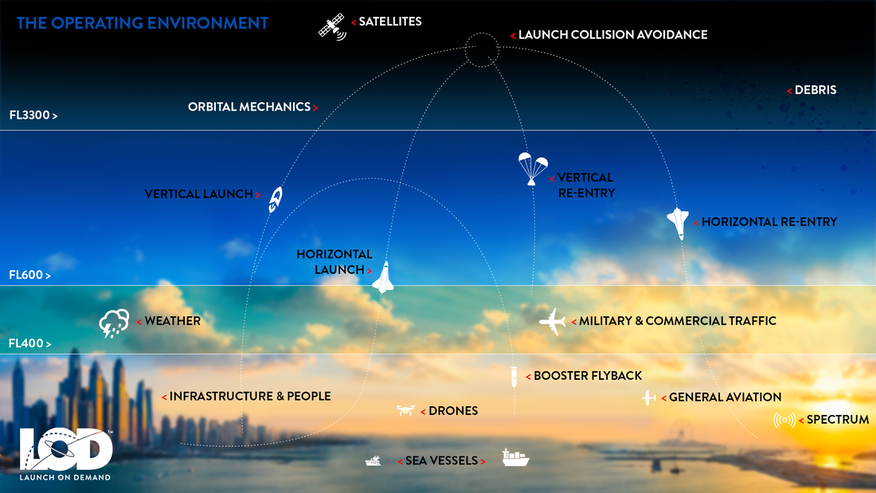THE CURRENT OPERATING ENVIRONMENT
Launches have traditionally relied on limited windows to ensure public safety and allow unimpeded access through the air domain; unfortunately, as the number of launches increase, windows become more inefficient. Launch opportunities are limited by vehicle performance, interagency adjudication of airspace priorities, and an unending list of other considerations.
INDUSTRIAL EXPANSION
0
Estimated Private Launches by 2025

0
New Satellites in Orbit by 2025
0
Only 16 capable launch locations in 2020

The number of global commercial launches is poised to explode and overwhelm currently available resources. The US commercial launch industry is on the cusp of a 300–500% increase in launch rates in the next 20 years. This is expected to press the currently available launch support capacity beyond its limit.
AIR TRAFFIC
As the number of space vehicle launches continues to increase, conflicts between space and air traffic are becoming more acute. Airlines are consuming more resources due to redirected flights which incur higher mileage; this is because aircraft must be redirected during launches to maintain a safe distance from spacecraft. According to the Airline Pilots Association in 2018, launches from the Kennedy Space Center, and Cape Canaveral delayed a total of 536 flights and required an additional 34,841 miles to be flown.


FREQUENCY MANAGEMENT
In a world that is constantly modernizing, the reliance on wireless communication and the movement of information is leading to an increased demand for wireless technology. Today, new technologies, the needs of other users (government and commercial), and the proliferation of wireless technologies worldwide have made maintaining even current spectrum allocations difficult. Wireless subscriber services are growing rapidly worldwide. Emerging countries, to modernize, are choosing to deploy wireless infrastructure in lieu of wired infrastructure since it costs less. All of these factors make a more competitive environment for worldwide spectrum access. This can create issues when deploying a launch vehicle; however, Inadvertent RF energy can hinder space vehicle subsystems such as rocket motors, pneumatics, release mechanisms, avionics, destructive ordinance, and telemetry traffic, resulting in a failed or flawed launch.
MARITIME TRAFFIC
With the ever-increasing reliance on seaborne vessels for the transportation of goods to and from continents, maritime traffic density is on the rise. This fact is so apparent that some shipping routes are permanently visible when plotted on a marine traffic map. Because of the importance and density of marine traffic, it has now become a factor when determining launch trajectories and times. In some cases, historical shipping lanes must be disrupted to ensure that falling debris will not impact any vessels that would otherwise be under an orbital launch trajectory. Circumventing heavily relied upon shipping lanes and fisheries in this manner can cost companies valuable time and money, making this an important factor that must be considered when deciding trajectories for launches.


ORBITAL DEBRIS
Orbital debris is one of the largest challenges that must be overcome when launching a space vehicle. There are an estimated 200,000 pieces of debris between 1 and 10 cm and millions smaller than 1 cm in orbit. Depending on the distance from earth, it can take several years to over a century for these objects to fall back into the earth’s atmosphere. This can pose a heavy risk to crewed and uncrewed launches with a 1 in 300 chance for a catastrophic collision. There are fears that with the growing amount of space debris, a collision between two pieces could occur, setting off a chain reaction resulting in low earth orbit being unusable.


